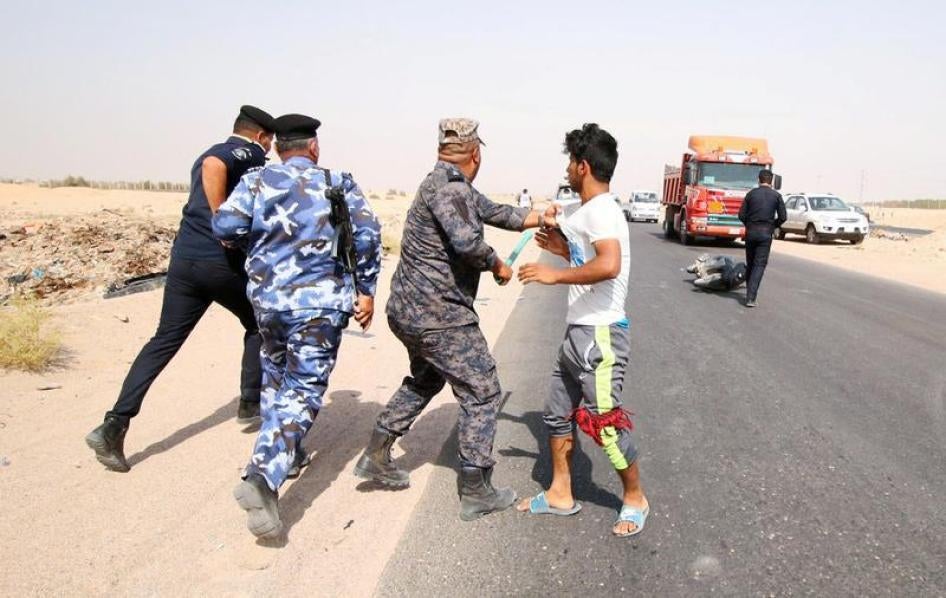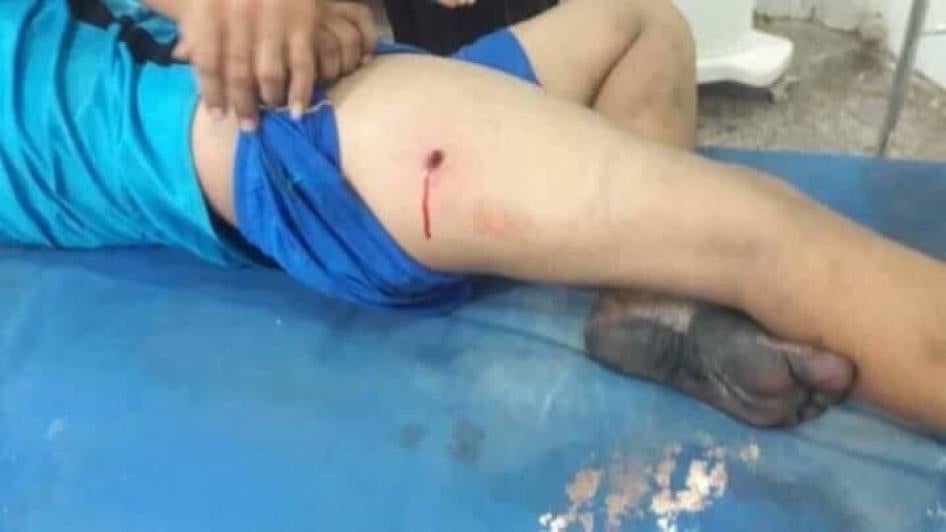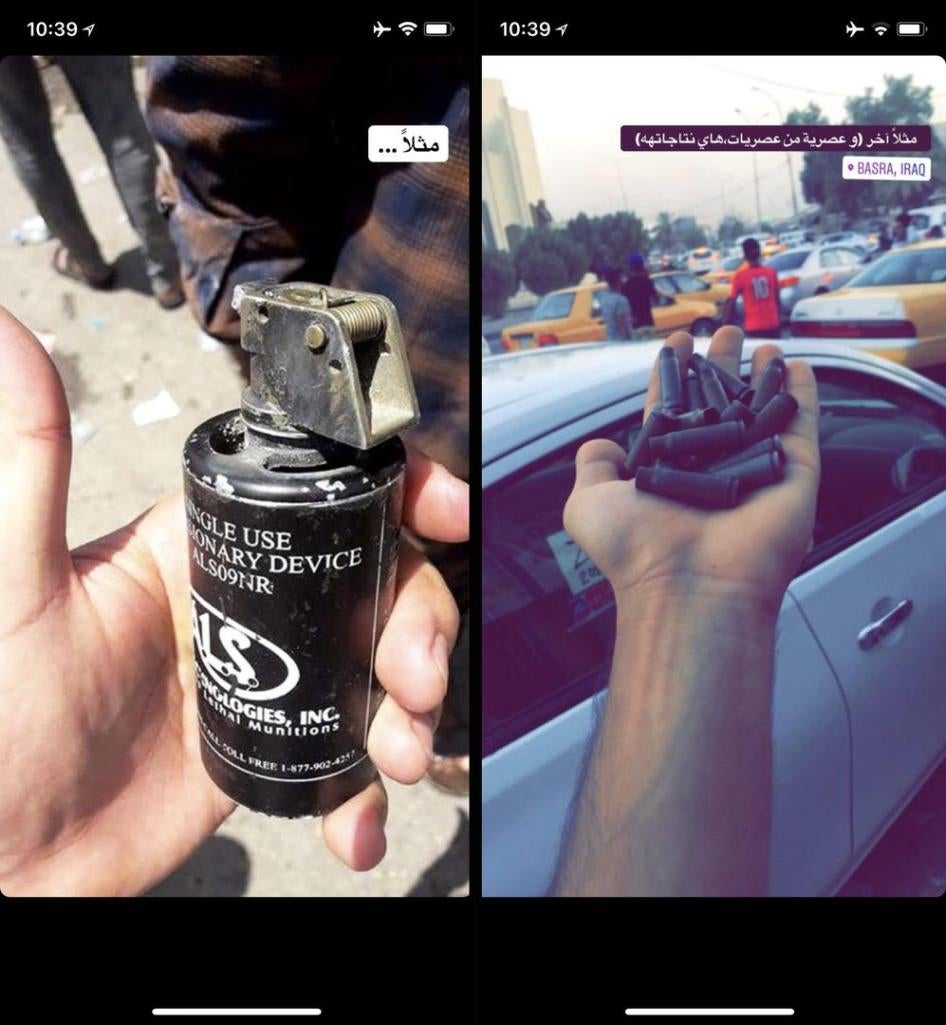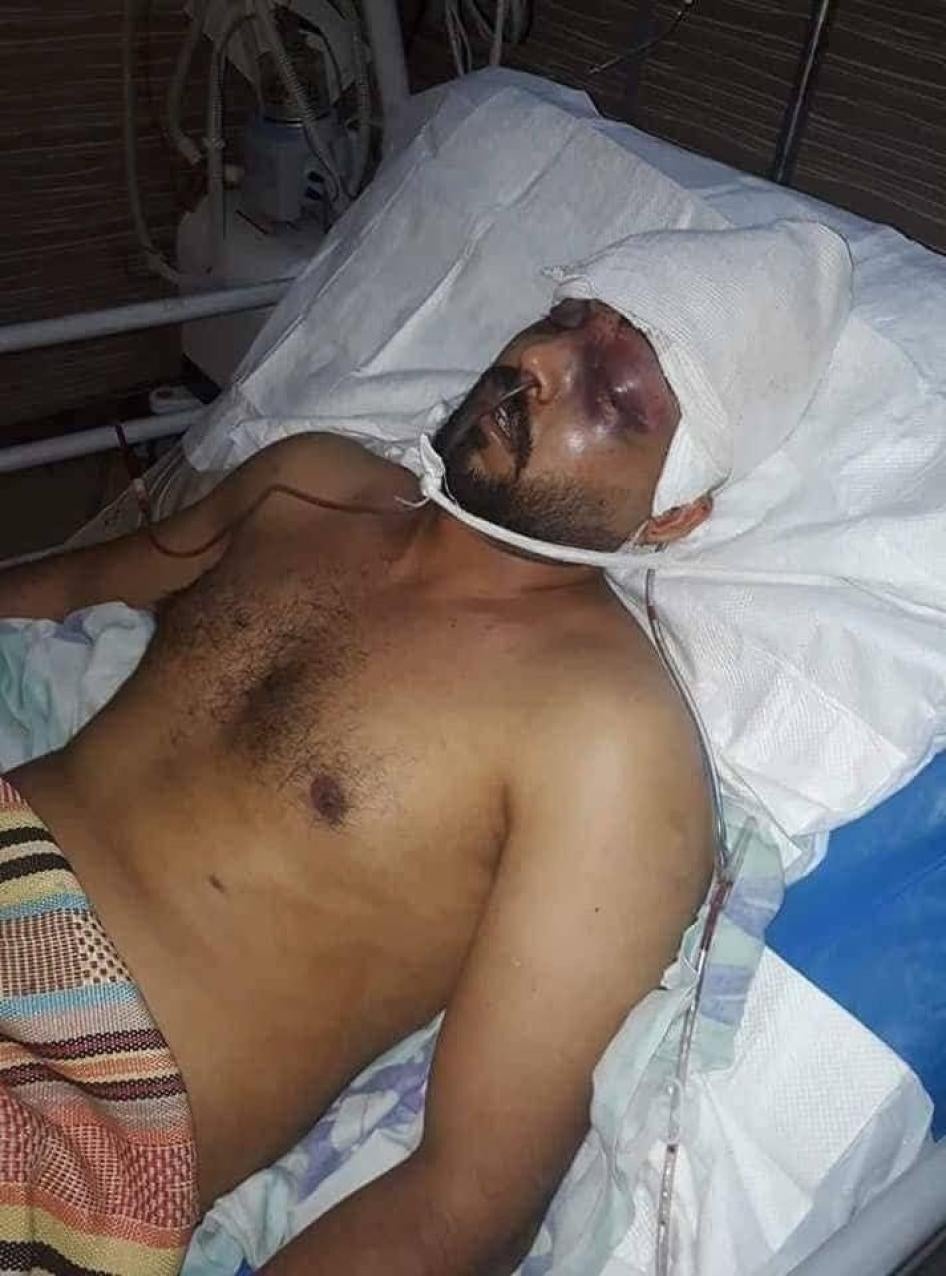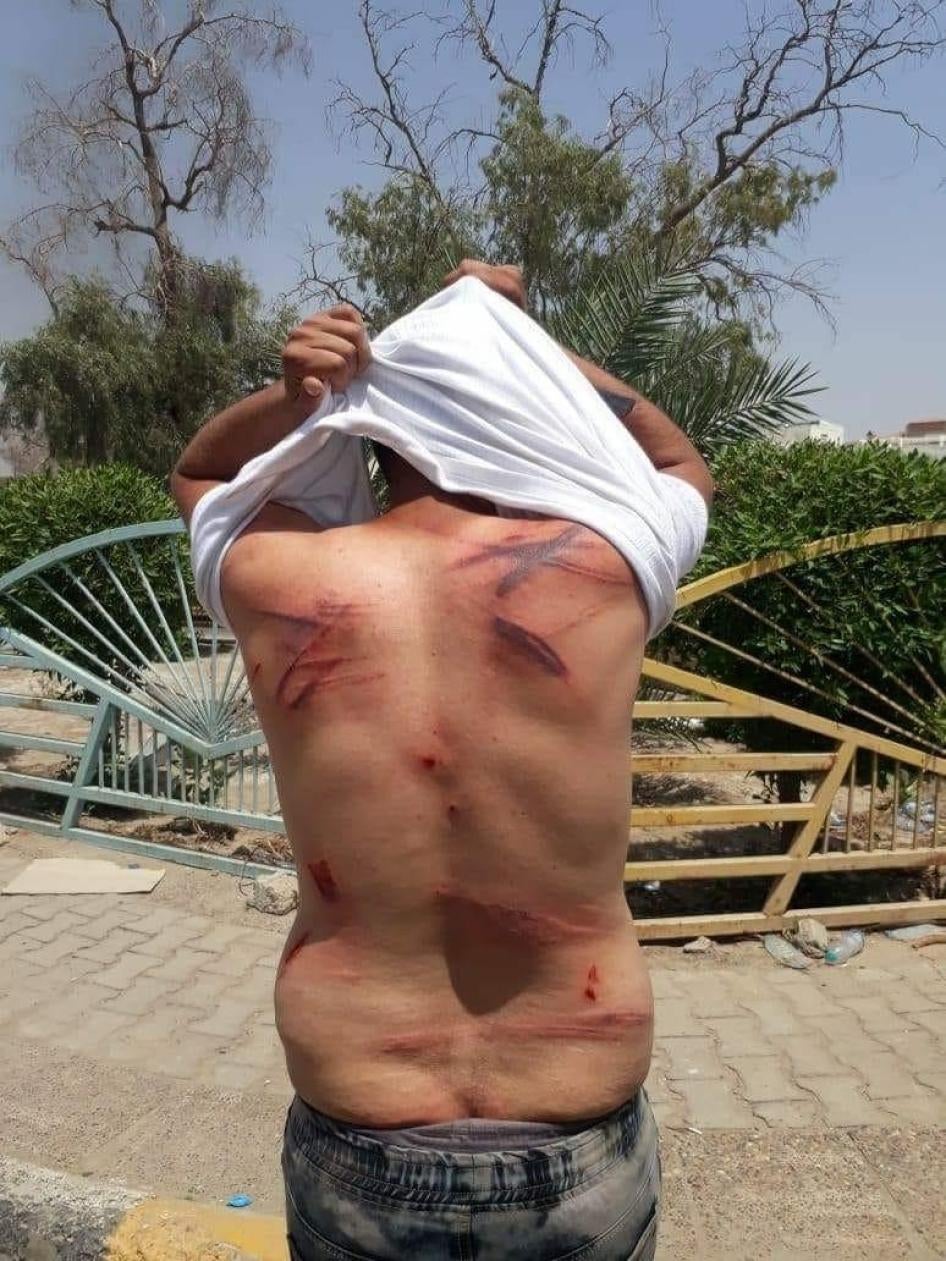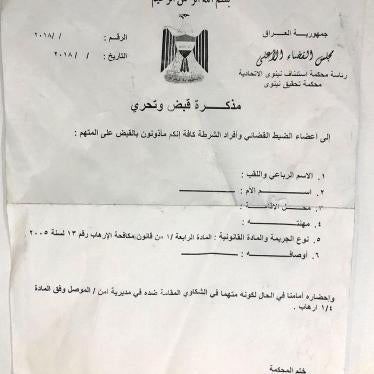About 20 of our friends left, but 10 of us refused to go or take down the tent. Then the forces started hitting all of us with thick plastic water pipes. At least two officers hit my head, arm and back, before dragging me into their pickup truck along with another six guys from the tent. They blindfolded us, bound our hands and took us to a checkpoint of theirs about two kilometers away, before releasing us from there. I got home and started throwing up blood so went to the doctor the next day for an MRI. He said I was ok though I might have a concussion.
Sufyan showed researchers photos of the red marks to his right arm and lower right back.
Protest on July 14 Outside of the Badr Organization Headquarters in Basra City
A journalist, “Sabah”, and a protester, “Maqsud,” said that on the night of July 14 in Basra City, security forces fired on the crowd several times without warning, wounding at least two children, ages 13 and 3, and detained at least two protesters. They said the protesters threw rocks at the security forces as well as at least one Molotov cocktail, and were burning tires.
Sabah and Maqsud said that they gathered with about 200 protesters that evening outside the Badr Organization headquarters in Basra. They said the protest began at about 8 p.m., with protesters dispersing around 9:30 p.m. and returning at midnight for another two hours. They said that during the initial protest, the protesters blocked the road with burning tires and threw rocks at about eight Badr forces who came outside to protect the building entrance.
They then saw the Badr forces respond to the rocks by firing on the crowd several times. Sabah saw a boy with blood coming from his body at the waistline, but he did not know if he was struck directly by bullets or indirectly with ammunition fragments. The boy’s relatives told Sabah he is 13.
Sabah said he saw protesters rip down and burn a banner of Hadi al-Amiri, the leader of the Badr Organization, and set it on fire, and one protester threw a Molotov cocktail at the Badr force members, hitting one of them.
Sabah left the protest and returned at midnight, when he saw Badr forces detain two protesters and drag them into their headquarters. He does not know what happened to them. He said that by then, there were more protesters who kept throwing rocks, and Badr forces kept opening fire for longer periods. At one point he said it felt like it was “raining bullets.” Sabah returned to his home 500 meters away at 2 a.m., and met his neighbor, who said he had been outside with his 3-year-old son earlier, when a metal fragment coming from the protest area hit his son, cutting his hand. He did not know how many people were wounded altogether.
Protest on July 15 at al-Burjisiya Oil Field
Three protesters said that on July 15 at al-Burjisiya oil field security forces opened fire on protesters without warning, chased them in vehicles, wounding one protester, and repeatedly beat at least three protesters with wooden sticks when dispersing the crowds. They said some protesters had been throwing rocks at the security forces.
At least 2,000 protesters headed to the oil field gates, about 18 kilometers from the nearest town, at 5:30 a.m. on July 15, the three protesters said. They blocked the road and then entered the oil field gate without meeting resistance from the oil police. The protesters said that at around 9 a.m., about 1,000 protesters passed through the gate, when about 10 Humvee armored vehicles and a few minibuses filled with men in SWAT uniforms and about eight armed men in civilian dress arrived.
A commander emerged from one of the Humvees and asked the protesters to select five to come in to present their demands to the director of the government oil company, but they refused, they said. About 300 protesters then walked toward the main building of ENI, one of the foreign oil companies at the field, at which point several Humvees drove in front of the group, blocking the road, and opened fire without warning, they said. The protesters started running toward the gate.
Ziad, one of the three, said a bullet whizzed by his head. He said he saw one Humvee near him strike a protester, who fell to the side of the road, but did not know what happened to him. He said:
Everyone was running in a different direction, but about 15 of us ran to a local police station inside the compound, and I ran and hid in the bathroom. SWAT forces followed us inside the station and found me in the bathroom. Three of them hit me at least five times with their “donkeys” [a wooden stick with a ball on the end used to herd donkeys], including on top of my head, my right hand and across my chest, while they were cursing at me.
Ziad escaped their grasp as they took him out of the bathroom and kept running in the direction of the nearest town. As he left the station, he said he saw a 20-year-old whom he knew in the back of one of their pickup trucks. “There were about 15 security force members hitting him, and I could hear him screaming, ‘I just want a job so I can get married.’”
Another protester, “Malik,” a 23-year-old barber, said that as they were running away, he saw four people carrying a protester whose left leg was bleeding. He did not know what had caused the injury or what happened to the protester. He said that as they were exiting the oil field gate, he saw three SWAT team members beating another protester’s back with their “donkeys.” He found the protester later and looked at his back, which was red and bruised, he said.
All three protesters said that some protesters had been throwing rocks at the security forces.
Protest on July 15 in Front of Basra Governorate Office
Seven protesters and three journalists said that on July 15, security forces opened fire on protesters outside of the Basra governorate office in the Basra city center without warning, killing at least one, wounding another two who are currently in comas, and wounding a fourth protester in the body, at the waistline. Security forces beat at least 24 protesters, including a child who looked to be about 12, with wooden sticks, plastic and metal pipes, cables, and rifle butts. Sixteen of them were in government custody at the time. Those interviewed said that some protesters had been throwing rocks at security forces and were burning tires.
All said they had been at the protests from 7 a.m. to 1 p.m. and then again from 5 p.m. to 6 p.m. on July 15. They said that anti-riot police and SWAT forces were outside to protect the building and disperse protesters. Inside the building gates, there were Interior Ministry’s Emergency Response Division forces and municipal police.
Two protesters and a journalist, “Hassan,” said they saw seven protesters carrying a young man away, with a large open wound to the left side of his head. Al-Saidi, the provincial council security chief, confirmed to Human Rights Watch that he later died. A protester, “Ayman,” and a journalist, “Sabah,” said they saw a man whom they later identified as Muhammad Abd Ali Naim, 24, lying on the ground with blood pouring from his head, whom protesters also swiftly carried away.
Three relatives of Naim, who remains in a coma, told Human Rights Watch they spoke to friends who took Naim from the protest to the hospital, and later gave the relatives his cell phone. A video from Naim’s phone shows a few protesters standing in front of the governorate office. There is the sound of gunfire and then the phone drops, indicating Naim has been hit. A doctor at Taleem Hospital showed Naim’s brother three metal fragments removed from his head after a three-hour operation. His prognosis is unclear.
One protester, “Karim,” 23, said that he was at the front line of protesters at about 10 a.m. when he saw a protester’s rock hit an anti-riot policeman. Security forces then grabbed him and five other protesters near the front of the governorate building and dragged him inside, he said. He saw the forces beat the protesters taken inside with black plastic sticks while cursing at them and calling them “terrorists,” he said. One policeman who knew the protesters helped them leave the building, putting them into an ambulance and driving them away.
As the group was getting out of the ambulance not far from the protest site, Karim said, he saw a child who looked to be about 12, standing alone, crying from the tear gas. He saw security force personnel open fire into the area above the child and then grab the child and drag him to their Humvee, beating him with the butts of their rifles. Karim does not know what happened to the child.
Hassan said that at about the same time he met a protester who showed him a six-centimeter open wound at his waistline, alleging that anti-riot police had hit him with a plastic pipe. One protester, “Ammar,” a 24-year-old university graduate, said he arrived at the protest at 11 a.m. and saw protesters burning tires, throwing rocks and trying to push through the gate into the governorate office, which he videoed. Anti-riot forces used their plastic shields to try to push the crowds back. He said the security forces first pulled back inside the gates, then rushed back out and started beating protesters with plastic pipes and wooden sticks.
“Aziz,” a protester, said that at this time he saw at least four anti-riot police beat a single protester with wooden sticks. Maqsud said he saw an anti-riot police pick up a rock that had been thrown in his direction and throw it back, hitting an old man in the head. He did not know what happened to the man. Maqsud said that right after this, he saw protesters trying to push their way into the governorate office. Anti-riot police responded with water cannons and teargas, firing cannisters directly into the crowd.
Maqsud said anti-riot police grabbed him and nine others shortly afterward and took them into the governorate building, beating them with metal pipes and plastic cables. He showed photos of red marks on the right side of his face, and his friend’s back, which had at least 18 red marks and open wounds. They both escaped from the office with the help of a friendly officer.
Ammar said he returned to the protests at 5 p.m. and saw a few hundred protesters had returned and were chanting peacefully. At 6 p.m., as he was leaving, anti-riot police suddenly started firing teargas. He ran into a nearby restaurant with three other protesters and sat at a table, pretending they were clients. He said that he watched through a window as about five officers beat three men in their custody, punching and slapping them, then drag them into civilian cars and drive away. He said:
One man in civilian clothes who was with them and carried a handgun suddenly saw us through the window. He pulled out his gun and shot directly at me, shattering the glass. I ran to the back and hid behind the freezer and listened as they dragged away the other three men who had been at the table with me. I waited until it was quieter and then headed home. When I got home, I saw that my clothing was covered in shattered glass.
“Ali,” 33, an artist taking part in the protest, said that at about the same time he saw one protester pull out a handgun and shoot toward the anti-riot police. He did not know if anyone was hit.
The brother of one protester, Muhammad Ali Zmat, 25, said that he had gone to the protest at about 5 p.m. The brother got a call shortly afterward from Zmat’s friends saying he had been hit by either a teargas canister or gunfire. The brother went to the hospital, where doctors had already performed surgery but said Zmat was in a coma and suffered brain damage from a projectile that hit his forehead, pushing bits of his skull into his brain. The brother showed a photo of Zmat in a coma in the hospital, with a large swelling to his eye and bandages around his head.
Protesters said they had held protests in the same location for two days prior to these incidents, in which security forces did not use any force against the protesters, which they captured on video clips.
Protest on July 16 at Lebanon Intersection, Basra City
Two protesters said that on July 16, security forces beat at least eight protesters with sticks. They said the protesters had been burning tires.
They had gone to an evening protest in Basra City at the Lebanon Intersection, where they saw protesters block the road with burning tires. One, Ammar, the university graduate, who watched the protest from afar, said that he saw five Federal Police officers beating at least eight protesters with sticks, then throw what appeared to be the protesters’ motorbikes off the bridge into the river. Ammar said he saw a separate group of seven Federal Police officers beating any apparent protester they could catch.
Protest on July 17 at al-Burjisiya Oil Field
The journalist Hassan said that on July 17 security forces opened fire without warning above the heads of protesters and beat them with sticks to disperse the crowds. One journalist was struck.
Hassan said he and his colleague, who was wearing a press badge, were interviewing some of the about 200 protesters near the oil field gate. He said that as they were interviewing a protester, an oil policeman suddenly came up to them and hit his colleague’s lower right leg. Another officer called out for him to stop, saying they were journalists. He said he saw the oil police officers hitting many of the other protesters to disperse the crowds.
